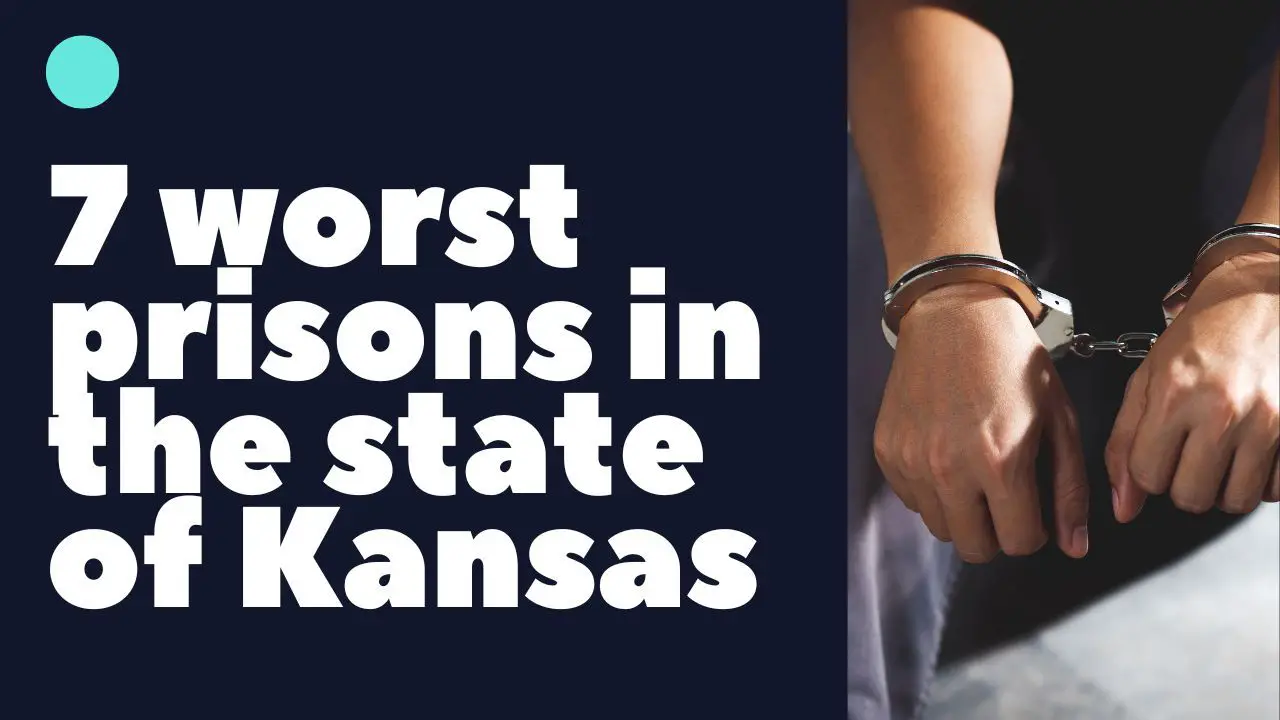10 Worst Prisons In The State of Kansas
What are some of the 10 worst prisons in the state of Kansas? We have discussed in this article the 10 worst prisons in Kansas based on crime rate and living conditioning.

Kansas may be known as the "Sunflower State," but that doesn't mean that its prisons are full of sunshine and rainbows. According to a recent report, the state has some of the worst prisons in the country.
In this article, we discuss the ten worst prisons in the State of Kansas. We use multiple metrics to determine why they are the worst prison and rank them ascendingly.
Why are Kansas prisons the worst
Following are some of the reasons why the prisons in the state of Kansas are the worst:
- Overcrowding and Understaffing: Kansas prisons are currently overcrowded, with over 7,000 inmates housed in facilities designed for under 5,500 people. This leaves little room for prisoners to move around or even lie down, leading to extreme tension and violence. The staff-to-inmate ratio is also very low, so guards are stretched thin and often unable to do their jobs effectively.
- Unsafe Conditions: The overcrowding and understaffing mentioned above create unsafe conditions for prisoners and guards alike. Inmates have been known to riot and start fires, while guards have been attacked by inmates or even taken hostage. These dangerous conditions make it hard for prisoners and staff to stay safe.
- Poor Healthcare: Kansas prisoners also have to deal with poor healthcare. There are currently not enough doctors or nurses to provide adequate care, which means that many prisoners go without basic medical care or treatment for serious illnesses. This can lead to preventable eaths or even infectious diseases spreading throughout the prison population.
Overview of Prisons in the state of Kansas
Many small counties and state prisons in Kansas house over 9,000 inmates. The average daily population of inmates in Kansas is 8,767, slightly higher than the national average of 8,768. An inmate's average stay in a Kansas state prison is 3.2 years. The vast majority of inmates in Kansas state prisons are male, with a ratio of 10:1.
The most common offense that leads to incarceration in a Kansas state prison is burglary, followed by drug offenses and robbery. Inmates in Kansas state prisons are housed in facilities that range from minimum-security to maximum-security, depending on the inmate's offense and security level.
All prisons in Kansas offer educational and vocational programs to inmates, as well as opportunities for religious services and counseling. Inmates who exhibit good behavior can earn privileges such as work release and access to recreational facilities.
List of worst prisons in the State of Kansas
- Lansing Correctional Facility
- El Dorado Correctional Facility
- Topeka Correctional Facility
- United States Penitentiary, Leavenworth
- Midwest Joint Regional Correctional Facility
- The United States Disciplinary Barracks
- Hutchinson Correctional Facility
Lansing Correctional Facility
Lansing Correctional Facility, formerly known as the Kansas State Penitentiary (KSP), began operations in the 1860s with prison labor. In 1990, the name was changed to Lansing Correctional Center. The cell blocks were completed in 1867. From July 1868 until 1909, it housed felons from Oklahoma.
Lansing Correctional Facility is a maximum-security prison located in Lansing, Kansas. The prison is overcrowded and understaffed. The living conditions are poor, and there have been reports of inmate abuse.
El Dorado Correctional Facility
EDCF has two general population cell houses and one medium security dormitory. EDCF is administratively linked to two minimum security units, formerly "honor camps," one in El Dorado and one in Toronto, Kansas.
However, due to budget constraints, the state announced in 2009 that both minimum security units would be closing. As of 2015, medium and minimum security units in Oswego were still part of EDCF even though they were administered separately.
This prison has been plagued by riots, inmate deaths, and overcrowding. In 2015, a riot left one inmate dead and several others injured. Since then, there have been multiple deaths at the hands of guards and an inmate who hanged himself in his cell.
Topeka Correctional Facility
The Topeka Correctional Facility is a state prison operated by the Kansas Department of Corrections. It was built in the 1970s and became the only women's prison in 1995. The prison facilitates a full range of security levels, from maximum to work-release.
The site on which the facility now stands was founded in 1905 as farmland for housing Topeka Industrial Institute - an African American school modeled after Tuskegee Insitute, which closed 50 years later in 1955.
In September 2009, The Topeka Capital Journal published investigative articles revealing a "complex black market" of contraband, bribery, and sex trafficking at the prison.
According to a 2011–2012 United States Department of Justice Civil Rights Division inquiry, the difficulties were not addressed. The Department of September 6, 2012 letter stated that "TCF fails to protect women, prisoners, from harm due to sexual abuse and misconduct by staff and other inmates in violation of their constitutional rights."
United States Penitentiary, Leavenworth
The United States Penitentiary, Leavenworth, is a medium-security prison with an adjacent minimum security satellite camp in northeast Kansas. It is operated by the Federal Bureau of Prisons, which falls under the jurisdiction of the Department of Justice. Male offenders classified as minimum-security are housed in the satellite federal prison camp located on the sprawling complex.
Frank Grigware was sent to prison for train robbery in 1910, but he quickly escaped Leavenworth with five other men by breaking through the gates with a stolen locomotive. The others were captured soon after, but Grigware made it to Canada. In 1916 he became the mayor of Spirit River, Alberta.
The prison is the worst due to its lack of security, inadequate food, and bad medical care. Basil Banghard has broken out of Leavenworth three times. While awaiting return to Leavenworth, he escaped from federal custody a fourth time.
Midwest Joint Regional Correctional Facility
The Midwest Joint Regional Correctional Facility (J.R.C.F.) is a military prison in Fort Leavenworth, Kansas, which opened in 2010 and houses male inmates.
The prison has a design specification of 512 beds, with 43 in special housing and the rest in general housing and dormitory. The prison handles inmates sentenced to terms of ten years or less. It also will house people who are awaiting trial. The Jesse Root Correctional Facility detained the inmates mentioned below until they were tried and sent to the Disciplinary Barracks by court-martial.
Chelsea Manning, who leaked government documents to WikiLeaks in 2010. Robert Bales was responsible for the Kandahar massacre of 16 Afghan civilians on 11 March 2012, are one of the main criminals in this prison.
The Midwest Joint Regional Correctional Facility has been dubbed the "worst" prison in the United States for various reasons. One reason is the high level of violence within its walls. And another reason the Midwest Joint Regional Correctional Facility is considered the worst prison in the United States is the conditions in which inmates are forced to live. The cells are often overcrowded and unsanitary, and there is little to no access to basic amenities like showers, toilets, and beds.
The United States Disciplinary Barracks
Leavenworth, Kansas's United States Disciplinary Barracks (USDB), commonly known as Leavenworth, is a military correctional facility located on Fort Leavenworth, a US Army post in Kansas.
The USDB was originally known as the United States Military Prison, established by the Act of Congress in 1874. Construction began in 1875 and finished in 1921, with prisoners utilizing most of the work. The facility could accommodate up to 1,500 inmates.
The United States Disciplinary Barracks, located at Fort Leavenworth, Kansas, is the military's only maximum-security prison. It houses some of the most dangerous criminals in the military, including terrorists and spies. But it's also plagued many problems, from overcrowding to inmate abuse.
In recent years, the Disciplinary Barracks has been embroiled in several scandals. In 2015, it was revealed that dozens of inmates had been held in solitary confinement for years, sometimes in cells smaller than a parking space. Inmates have also complained of being denied medical care and forced to drink dirty water.
Hutchinson Correctional Facility
Hutchinson Correctional Facility, located in Hutchinson, Kansas, is a state prison operated by the Department of Corrections. The Hutchinson Correctional Facility was first called the Kansas State Industrial Reformatory and was intended for younger criminals. Building started on KSIR in 1885, but various obstacles pushed back the date that inmates could be housed there until 1895.
At HCF, low-security offenders may work on various projects, including highway maintenance, clean-up, and upkeep at the state fair every year, as well as helping several public works departments in Hutchinson and maintenance at Cheney State Park. The prison also offers the Kansas Wild Horse Program, which trains horses taken from Bureau of Land Management property.
Hutchinson Correctional Facility is the worst because of the conditions in which the inmates are forced to live. The cells are small and cramped, the food is terrible, and the guards are often rude and abusive. Inmates at Hutchinson have very little to look forward to each day, and it is no wonder many of them commit suicide.
You can also read articles related to this topic;
- 10 Worst Prisons in the State of Virginia
- The 10 Worst Prisons In The State of Oregon
- 10 Worst Prisons In The State of New Hampshire
- 10 Worst Prisons in the State of Oklahoma
- 7 Worst Prisons in The State of Utah
- 6 Worst Prisons In The State of Hawaii
- 6 Worst Prisons In The State Of Alaska
- 10 Worst Prisons In The State of Montana
- 7 Worst Prisons In The State Of New Mexico
- Worst Prisons In The State Of West Virginia
